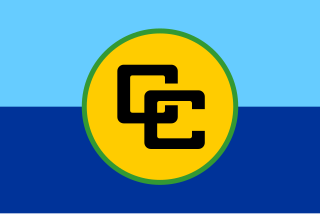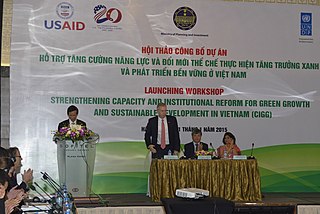Related Research Articles

The World Food Programme (WFP) is an international organization within the United Nations that provides food assistance worldwide. It is the world's largest humanitarian organization and the leading provider of school meals. Founded in 1961, WFP is headquartered in Rome and has offices in 80 countries. As of 2021, it supported over 128 million people across more than 120 countries and territories.
The United Nations Development Programme (UNDP) is a United Nations agency tasked with helping countries eliminate poverty and achieve sustainable economic growth and human development. The UNDP emphasizes developing local capacity towards long-term self-sufficiency and prosperity.

The Caribbean Disaster Emergency Management Agency (CDEMA) is an inter-regional supportive network of independent emergency units throughout the Caribbean region. Formed on September 1, 2005, as the Caribbean Disaster Emergency Response Agency (CDERA), it underwent a name change to CDEMA in September 2009.

The Directorate-General for European Civil Protection and Humanitarian Aid Operations, formerly known as the European Community Humanitarian Aid Office, is the European Commission's department for overseas humanitarian aid and for civil protection. It aims to save and preserve life, prevent and alleviate human suffering and safeguard the integrity and dignity of populations affected by natural disasters and man-made crises. Since September 2019, Janez Lenarčič is serving as Commissioner for Crisis Management in the Von der Leyen Commission, and since 1 March 2023, Maciej Popowski leads the organisation as the Director-General.

A humanitarian crisis is defined as a singular event or a series of events that are threatening in terms of health, safety or well-being of a community or large group of people. It may be an internal or external conflict and usually occurs throughout a large land area. Local, national and international responses are necessary in such events.
The World Conference on Disaster Risk Reduction is a series of United Nations conferences focusing on disaster and climate risk management in the context of sustainable development. The World Conference has been convened three times, with each edition to date having been hosted by Japan: in Yokohama in 1994, in Hyogo in 2005 and in Sendai in 2015. As requested by the UN General Assembly, the United Nations Office for Disaster Risk Reduction (UNDRR) served as the coordinating body for the Second and Third UN World Conference on Disaster Reduction in 2005 and 2015.

In international relations, aid is – from the perspective of governments – a voluntary transfer of resources from one country to another.

Capacity building is the improvement in an individual's or organization's facility "to produce, perform or deploy". The terms capacity building and capacity development have often been used interchangeably, although a publication by OECD-DAC stated in 2006 that capacity development was the preferable term. Since the 1950s, international organizations, governments, non-governmental organizations (NGOs) and communities use the concept of capacity building as part of "social and economic development" in national and subnational plans. The United Nations Development Programme defines itself by "capacity development" in the sense of "'how UNDP works" to fulfill its mission. The UN system applies it in almost every sector, including several of the Sustainable Development Goals to be achieved by 2030. For example, the Sustainable Development Goal 17 advocates for enhanced international support for capacity building in developing countries to support national plans to implement the 2030 Agenda.
There are a number of meanings for the term humanitarian. Here, humanitarian pertains to the practice of saving lives and alleviating suffering. It is usually related to emergency response whether in the case of a natural disaster or a man-made disaster such as war or other armed conflict. Humanitarian principles govern the way humanitarian response is carried out.

Disaster risk reduction (DRR) is a systematic approach to identifying, assessing and reducing the risks of disaster. It aims to promote sustainable development by increasing the resilience of communities to any disasters they might face. DRR is normally used as policies intended to "define goals and objectives across different timescales and with concrete targets, indicators and time frames." The concept is also called disaster risk management (DRM).
The Humanitarian Response Index (HRI) is an independent civil society initiative to annually assess and rank wealthy countries against their commitment to improve the quality and effectiveness of their humanitarian assistance. Developed by DARA, the HRI's intended purpose is to assist the Organisation for Economic Co-operation and Development's Development Assistance Committee (OECD/DAC) donor governments ensure that their humanitarian assistance has the greatest impact on beneficiaries. The HRI's aim is to improve the quality and effectiveness of aid, and promote greater efficiency, effectiveness, transparency and accountability of government donors. The first edition was published in 2007, followed by subsequent editions in 2008, 2009, and 2010.
Humanitarian Initiative Just Relief Aid (HIJRA) is an African humanitarian organization focused on the implementation of emergency and resilience programming in the greater Horn of Africa; Somalia, Kenya and Uganda.
The Climate Vulnerability Monitor (CVM) is an independent global assessment of the effect of climate change on the world's populations brought together by panels of key international authorities. The Monitor was launched in December 2010 in London and Cancun to coincide with the UN Cancun Summit on climate change (COP-16). Developed by DARA and the Climate Vulnerable Forum, the report is meant to serve as a new tool to assess global vulnerability to various effects of climate change within different nations.
The Emergency Capacity Building Project is a collaborative capacity-building project aimed at improving the speed, effectiveness and delivery of humanitarian response programs. The ECB Project is a partnership between seven non-governmental organizations (NGOs), and implements programs in one region and four countries known as consortia.
The Regional Center for Disaster Information for Latin America and the Caribbean (CRID) is a specialized center for the region of the Americas for information on risk management. It was founded in 1990, by cooperating agencies and organizations. The goal was to create a platform for inter-sectoral coordination and collaboration to promote development of a culture of Disaster Risk Reduction (DRR) within the region. Approaches include analysis, systematization and diffusion of information on risk management, promotion and strengthening of information centers, cooperative efforts with key players and a response to requirements from stakeholders.

The United Nations Office for Disaster Risk Reduction (UNDRR) was created in December 1999 to ensure the implementation of the International Strategy for Disaster Reduction.

The United Nations World Humanitarian Summit (WHS) was held in Istanbul, Turkey, on May 23 and 24, 2016. The summit was an initiative of the Secretary-General of the United Nations Ban Ki-moon and was organized by the United Nations Office for the Coordination of Humanitarian Affairs.

The All India Disaster Mitigation Institute (AIDMI) is a NGO registered in India. Located at Ahmedabad, Gujarat, India, it works on disaster risk reduction, climate change adaptation and disaster mitigation. It is a community-based ; action planning, action research and advocacy organization, working towards bridging the gap between policy, practice and research related to disaster mitigation. AIDMI have been working on six pillars: (i) Awareness generation, (ii) Capacity building, (iii) Policy advocacy, (iv) Direct implementation, (v) Research and publications, and (vi) Networking.
In Afghanistan, poverty is widespread in rural and urban areas. However, it has been estimated that poverty in Afghanistan is mainly concentrated in rural areas. It has been estimated that four out of five poor people live in rural areas. In these rural areas, families without enough access to adequate nutrition see many infants and children become stunted, malnourished, and die each year. The regions in Afghanistan where almost half of the inhabitants are poor are the East, Northeast, and West-Central regions. According to the Afghan government's estimates, 42 percent of the Afghanistan's total population lives below the poverty line. Also, 20 percent of people living just above the poverty line are highly vulnerable to falling into poverty.
The WorldRiskReport is an annual technical report on global disaster risks. The yearly issues of the WorldRiskReport focus on varying critical topics related to disaster risk management and are published in German and English. The report includes the WorldRiskIndex, which identifies the risk of an extreme natural event becoming a disaster for 181 countries worldwide.
References
- ↑ "DEVELOPMENT ASSISTANCE RESEARCH ASSOCIATES SL". InfoCIF. Retrieved 27 November 2020.
- ↑ About us - DARA
- ↑ "International Development - Heroes or zeroes? Dara's HRI breaks down aid effectiveness". Archived from the original on 2011-07-24. Retrieved 2010-12-13.
- 1 2 What we do - DARA
- ↑ "Who we are - DARA".
- ↑ Humanitarian Response Index 2009: Clarifying Donor Priorities | Brookings Institution
- 1 2 International Development - Dara co-founder seeks ways to improve humanitarian relief
- ↑ European Development Days | Archived 2011-07-20 at the Wayback Machine
- ↑ High Commission of the Republic of MALDIVES | President Nasheed Launches Climate Vulnerable Monitor 2010 Archived March 4, 2012, at the Wayback Machine
- ↑ http://live.tcktcktck.org/2010/12/the-time-to-act-is-now-new-report-predicts-10-million-climate-deaths-by-2030/%5B%5D
- ↑ "Archived copy". Archived from the original on 2011-02-04. Retrieved 2011-01-19.
{{cite web}}: CS1 maint: archived copy as title (link) - ↑ Latin bloc scolds rich countries at climate talks
- ↑ "What is the Risk Reduction Index (RRI)? | Dara". Archived from the original on 2011-01-04. Retrieved 2010-12-16.
- ↑ "DARA welcomes ed Schenkenberg as new Chief Executive - DARA".
- ↑ "Rescue Global - Crisis and Disaster Response" . Retrieved 2016-07-24.
- ↑ Funding and Support - DARA